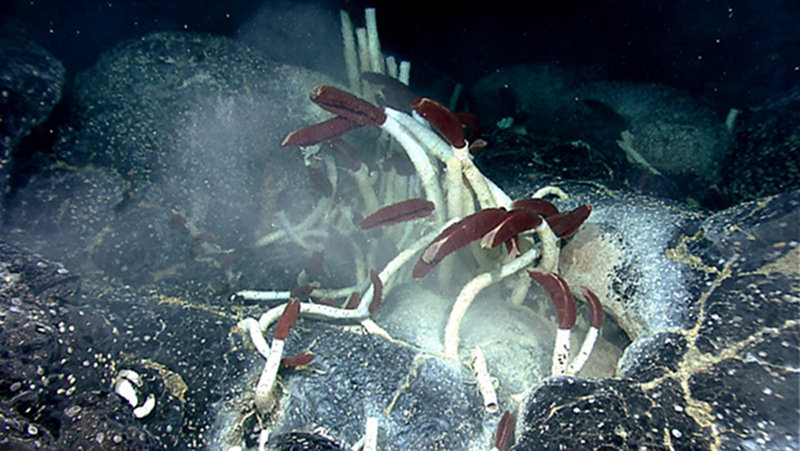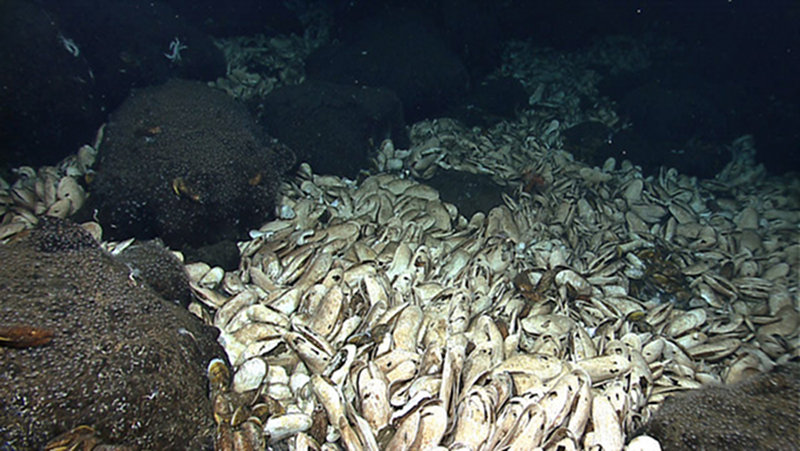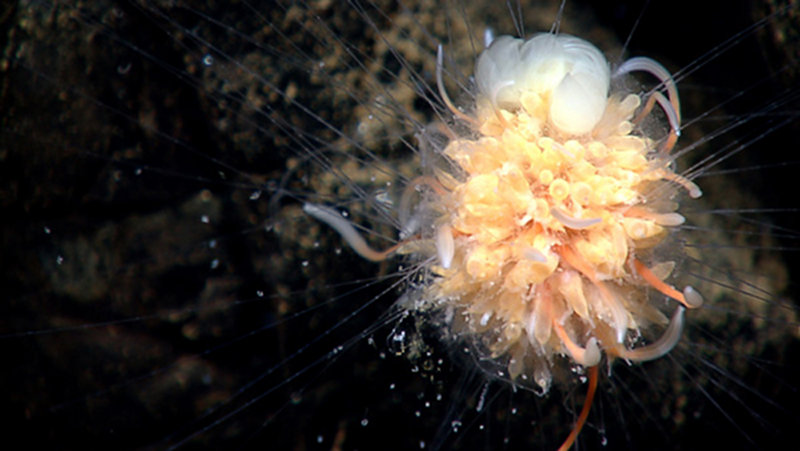
By Taylor Heyl, Santiago Herrera, and Catriona Munro - WHOI Exploration Command Center
and Tim Shank, Associate Scientist - Woods Hole Oceanographic Institution
Typical when exploring unknown areas of the deep-ocean, feelings of great anticipation that we would discover something that could fundamentally change the way we think about deep-ocean geology and biology flooded our thoughts. We had already discovered strong evidence for recent eruptions on the neighboring ridge segment: microbial blooms and the absence of any sessile animal colonization. We had also just visited an area where we knew a vent field existed 6 years ago, that was now apparently no longer there. What would today bring? Today we descended with Little Hercules to a location on the eastern limb of the Galápagos Rift where a strong hydrothermal plume signal (4a west) was recently observed. Hopes were high and feelings were anxious.
On bottom, we explored the landing site near 85° 54.648 W, 00° 46.104 N at a depth of 2560m before moving to the west. We located what looked to be active fissures and grabens in the area. A graben is an elongated block of the earth’s crust lying between two faults and displaced downward relative to the blocks on either side, as in a rift valley. Places of faulting are good candidates to find hydrothermal activity, as the breaks in the rocks provide the necessary permeability for hydrothermal vent formation and maintenance. Upon reaching an active graben, Little Hercules moved through water laden with increasing particulates, and encountered pillow lavas that hosted increasing numbers of brachyuran crabs. It became clear that we were close to hydrothermal activity. We came upon the edge of an extensive field of empty clam shells, likely of the species Calyptogena magnifica. Patches of Riftia tubeworms, mostly small cm-long colonizing individuals, but a few large ones, with tube lengths reaching approximately 70 cm in length were observed living amid shimmering water rising from between pillow lavas and lobes.

Riftia tubeworms colonize diffuse vent habitats between broken pieces of lava. Small mussels, less than two inches, were growing in cracks adjacent to vent openings (lower right). Image courtesy of NOAA Office of Ocean Exploration and Research. Download larger version (jpg, 1.5 MB).

Extensive beds of the giant clam Calyptogena magnifica were in abundance at Tempus Fugit. Image courtesy of NOAA Office of Ocean Exploration and Research. Download larger version (jpg, 1.48 MB).
We began surveying the vent field, first exploring the areas of diffuse flow and then around the perimeter to get a sense of the dimensions of the entire field. Given the extent of living and dead clams around the periphery, this may be one of the largest vent fields found yet on the Galapagos Rift (spanning 130m by 40m). This low-temperature hydrothermal vent field was named the “Tempus Fugit Vent Field”—loosely translated from Latin as “time waits for no one”—has been the focused location of varying periods of hydrothermal activity for at least the past 20 years, as indicated by the presence of extensive beds of clam shells, broken and deteriorating, both along the margins of the field as well as in the central active venting area. A few live clams were observed in the active center of the field as well as in the margin (an abundance of shells were > 25 cm in length). In the active-flow areas, there was evidence of recent colonization by small (< 2cm long) tubeworms including Riftia, Oasisia, and potentially Tevnia, a species previously unknown from the Galapagos Rift, along with highly–abundant, yet small (< 3cm long) bathymodiolin mussels filling cracks and crevices in the lobate lavas.

This beautiful creature referred to as “dandelion” was discovered by geologists during a 1977 expedition. Scientists now know that it is a siphonophore, a relative of the Portuguese man-of-war. Image courtesy of NOAA Office of Ocean Exploration and Research. Download larger version (jpg, 1.3 MB).
White aggregations of mineral sulfides and microbial mats of diverse textures were observed in diffuse flow areas, between relatively young lobate lava flows. Much of the rock in these areas had dark discoloration, likely caused by the grazing activity of a least 4 species of limpets on the white microbial material. Among the dominant residents of the vent field were dandelion siphonophores, particularly abundant along all margins of the field, alvinocarid shrimp and anemones.
Hydrothermal vents are known to be ephemeral on temporal and spatial scales, and this newly-discovered vent field, Tempus Fugit, illustrates dramatically how temporal dynamics happen within vent sites as well as within biological communities. We know that major fluxes of venting activity (i.e., activation and cessation) and volcanic disturbance events (i.e., eruptions and diking) can occur over decadal time scales, maybe even longer on certain slow-spreading ridge crests, while the frequency of these events on fast-spreading ridges may yield vent activity that persists for only a few months or years on fast-spreading ridges. Examples of the later are the vent fields on the East Pacific Rise and Juan de Fuca Ridge, which often experience eruptions or cracking events that form new venting habitats or re-locate venting areas, and remove the evidence of old biological communities. The intermediate-spreading ridge on which the Tempus Fugit Vent Field resides is a clear example of an environment where past and present co-exist, here dynamic hydrothermal processes control the structure of these vent communities.